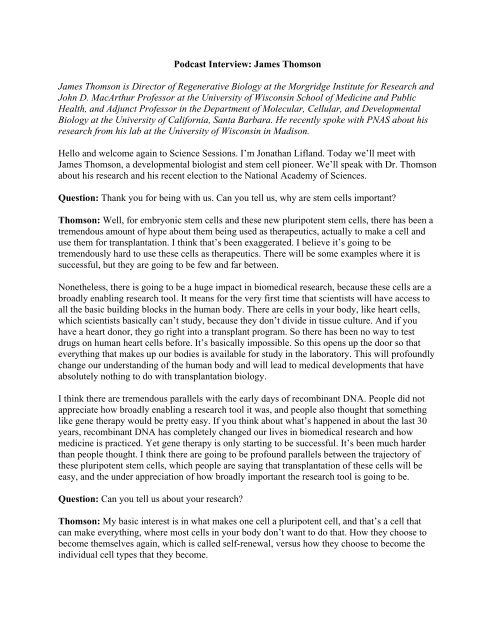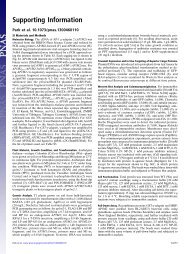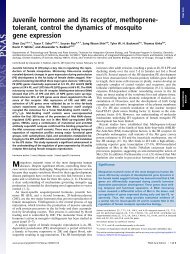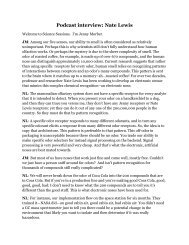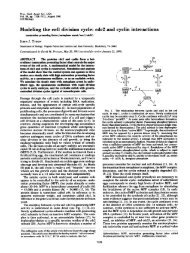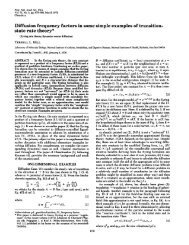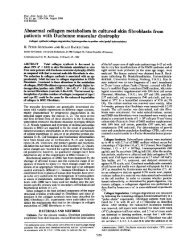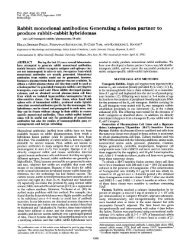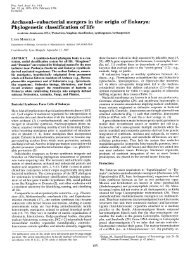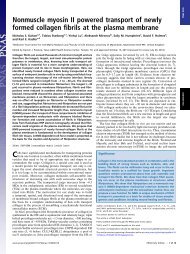Podcast Interview: Jennifer Lippincott-Schwartz - Proceedings of the ...
Podcast Interview: Jennifer Lippincott-Schwartz - Proceedings of the ...
Podcast Interview: Jennifer Lippincott-Schwartz - Proceedings of the ...
You also want an ePaper? Increase the reach of your titles
YUMPU automatically turns print PDFs into web optimized ePapers that Google loves.
<strong>Podcast</strong> <strong>Interview</strong>: James Thomson<br />
James Thomson is Director <strong>of</strong> Regenerative Biology at <strong>the</strong> Morgridge Institute for Research and<br />
John D. MacArthur Pr<strong>of</strong>essor at <strong>the</strong> University <strong>of</strong> Wisconsin School <strong>of</strong> Medicine and Public<br />
Health, and Adjunct Pr<strong>of</strong>essor in <strong>the</strong> Department <strong>of</strong> Molecular, Cellular, and Developmental<br />
Biology at <strong>the</strong> University <strong>of</strong> California, Santa Barbara. He recently spoke with PNAS about his<br />
research from his lab at <strong>the</strong> University <strong>of</strong> Wisconsin in Madison.<br />
Hello and welcome again to Science Sessions. I’m Jonathan Lifland. Today we’ll meet with<br />
James Thomson, a developmental biologist and stem cell pioneer. We’ll speak with Dr. Thomson<br />
about his research and his recent election to <strong>the</strong> National Academy <strong>of</strong> Sciences.<br />
Question: Thank you for being with us. Can you tell us, why are stem cells important?<br />
Thomson: Well, for embryonic stem cells and <strong>the</strong>se new pluripotent stem cells, <strong>the</strong>re has been a<br />
tremendous amount <strong>of</strong> hype about <strong>the</strong>m being used as <strong>the</strong>rapeutics, actually to make a cell and<br />
use <strong>the</strong>m for transplantation. I think that’s been exaggerated. I believe it’s going to be<br />
tremendously hard to use <strong>the</strong>se cells as <strong>the</strong>rapeutics. There will be some examples where it is<br />
successful, but <strong>the</strong>y are going to be few and far between.<br />
None<strong>the</strong>less, <strong>the</strong>re is going to be a huge impact in biomedical research, because <strong>the</strong>se cells are a<br />
broadly enabling research tool. It means for <strong>the</strong> very first time that scientists will have access to<br />
all <strong>the</strong> basic building blocks in <strong>the</strong> human body. There are cells in your body, like heart cells,<br />
which scientists basically can’t study, because <strong>the</strong>y don’t divide in tissue culture. And if you<br />
have a heart donor, <strong>the</strong>y go right into a transplant program. So <strong>the</strong>re has been no way to test<br />
drugs on human heart cells before. It’s basically impossible. So this opens up <strong>the</strong> door so that<br />
everything that makes up our bodies is available for study in <strong>the</strong> laboratory. This will pr<strong>of</strong>oundly<br />
change our understanding <strong>of</strong> <strong>the</strong> human body and will lead to medical developments that have<br />
absolutely nothing to do with transplantation biology.<br />
I think <strong>the</strong>re are tremendous parallels with <strong>the</strong> early days <strong>of</strong> recombinant DNA. People did not<br />
appreciate how broadly enabling a research tool it was, and people also thought that something<br />
like gene <strong>the</strong>rapy would be pretty easy. If you think about what’s happened in about <strong>the</strong> last 30<br />
years, recombinant DNA has completely changed our lives in biomedical research and how<br />
medicine is practiced. Yet gene <strong>the</strong>rapy is only starting to be successful. It’s been much harder<br />
than people thought. I think <strong>the</strong>re are going to be pr<strong>of</strong>ound parallels between <strong>the</strong> trajectory <strong>of</strong><br />
<strong>the</strong>se pluripotent stem cells, which people are saying that transplantation <strong>of</strong> <strong>the</strong>se cells will be<br />
easy, and <strong>the</strong> under appreciation <strong>of</strong> how broadly important <strong>the</strong> research tool is going to be.<br />
Question: Can you tell us about your research?<br />
Thomson: My basic interest is in what makes one cell a pluripotent cell, and that’s a cell that<br />
can make everything, where most cells in your body don’t want to do that. How <strong>the</strong>y choose to<br />
become <strong>the</strong>mselves again, which is called self-renewal, versus how <strong>the</strong>y choose to become <strong>the</strong><br />
individual cell types that <strong>the</strong>y become.
More broadly, I’m interested in what imparts a cell’s identity: why is your liver cell a liver cell<br />
and your heart cell a heart cell, and why are <strong>the</strong>y normally really stable? Why are <strong>the</strong>y in those<br />
conditions for life in most cases? Can we change that cell identity? That was <strong>the</strong> surprising thing<br />
with induced pluripotent cells, it turns out that you can change cells’ identity with a relatively<br />
small manipulation <strong>of</strong> just a few factors. I think you’ll find in <strong>the</strong> future that <strong>the</strong>re will be a lot <strong>of</strong><br />
examples <strong>of</strong> cells changing identity, not back to a ground state, not back to <strong>the</strong> pluripotent state,<br />
but between different cell types in <strong>the</strong> body.<br />
Question: Are <strong>the</strong>re any instances where what you have seen has surprised you?<br />
Thomson: I guess <strong>the</strong> biggest surprise for <strong>the</strong> field, and in my lab also, is reprogramming. Dolly<br />
[<strong>the</strong> sheep] was cloned about a year before—or at least <strong>the</strong> publication was a year before—<br />
human embryonic stem cells were published by my lab. The two are already paired in <strong>the</strong> public<br />
imagination from that early time. The message from Dolly was not that you can clone sheep, and<br />
it was not that you could do somatic cell nuclear transfers and make an embryonic stem cell, it<br />
was that transfecting stuff could reprogram an adult cell into an embryonic cell. It was only a<br />
matter <strong>of</strong> time before people would identify that transfecting stuff. The surprise was that it<br />
wasn’t as complicated as everybody thought. I would have guessed that it was 50-100 factors,<br />
and it turns out that 2-4 is sufficient. But <strong>the</strong> bottom line is that a very small number <strong>of</strong> factors<br />
can completely change <strong>the</strong> developmental state <strong>of</strong> a cell. That was unanticipated.<br />
Question: How and why do stem cells choose to differentiate into different types <strong>of</strong> cells?<br />
Thomson: Basically, cells talk to each o<strong>the</strong>r through external signaling molecules, <strong>the</strong> things<br />
that diffuse between cells or which are linked to <strong>the</strong> cell surface, and depending on how those<br />
signals are emitted and received, cells can turn into new cells. So for stem cells in tissue culture<br />
dishes, we can look at all that developmental biology and say, what growth factor does this in a<br />
normal embryo, and we can try that in a tissue culture dish, and <strong>of</strong>ten <strong>the</strong>y are <strong>the</strong> same<br />
molecules that can do <strong>the</strong> same thing.<br />
Question: How do you feel to be elected into <strong>the</strong> National Academy <strong>of</strong> Sciences?<br />
Thomson: It’s a good feeling. It means that you’re publicly accepted. An awful lot <strong>of</strong> what has<br />
driven <strong>the</strong> publicity in stem cell research is hype, but it certainly means more to be accepted by<br />
your peers and recognized by your peers, so it’s a big deal.<br />
Question: Thank you very much for your time.<br />
James Thomson is <strong>the</strong> director <strong>of</strong> regenerative biology at <strong>the</strong> Morgridge Institute for Research<br />
and <strong>the</strong> John D. MacArthur pr<strong>of</strong>essor at <strong>the</strong> University <strong>of</strong> Wisconsin School <strong>of</strong> Medicine and<br />
Public Health. He was elected to <strong>the</strong> National Academy <strong>of</strong> Sciences in 2008.


